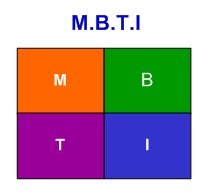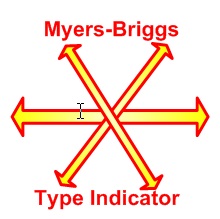Myers-Briggs Type Indicator
The Myers-Briggs Type Indicator (MBTI) was developed by Isabel Myers and Katherine Briggs based on the teachings of Carl Jung. The MBTI is a self-inventory questionnaire that helps identify a person’s personality type and preferences. The questionnaire is designed to measure psychological preferences in how people perceive the world and make decisions.
The model classifies individuals according to their behavioral preferences on scales derived from Jung’s theory of psychological types. The MBTI system uses a four scale structure for identifying and categorizing individuals, and each of the four scales represents two opposing preferences. The questions ask:
Where do you prefer to direct your energy?
How do you prefer to process information?
How do you prefer to make decisions?
How do you prefer to organize your life?
Based on the answers to the questions, people are identified as having one of 16 personality types.
| Extraversion Introvert |
| Sensing Intuition |
| Thinking Feeling |
| Judging Perceiving |
The ultimate goal of the MBTI is to allow people to explore and understand their own personalities including his or her strengths, weaknesses, and general preferences. It can also help determine career preferences that would best match his or her personality.
According to MBTI model, there are four areas of personality that affect learning. The model categorizes results based upon four dimensions:
| Area of Personality | How A Person |
| Extraversion vs. Introversion | directs their energy |
| Sensing vs. Intuition | processed information |
| Thinking vs. Feeling | makes decisions |
| Judging vs. Perceiving | organization preferences |
AREA OF PERSONALITY
Extraversion (E) – Introversion (I)
The Extraversion-Introversion spectrum describes how people respond and interact with the world around them.
Extraverts tend to be action-oriented, enjoy frequent social interaction, and feel energized after spending time with other people.
Introverts tend to be thought-oriented, and find energy in the inner world of ideas, concepts, and abstractions. They typically feel reenergized after spending time alone.
Sensing (S) – Intuition (N)
This Sensing-Intuition scale focuses on how people gather information from the world around them.
Sensing people tend to pay attention to the facts, especially to what they can learn from their own senses. Sensing people are detail oriented and enjoy getting hands-on experience.
Intuitive people seek out patterns and relationships among the facts they have collected, and trust their hunches and intuition. They prefer to deal with ideas, look into the unknown, to generate new possibilities or abstract theories.
Thinking (T) – Feeling (F)
This Thinking-Feeling continuum focuses on how people make decisions based on the information that they have gathered.
People who prefer thinking focus on facts and decide using logic and objective data. They tend to be consistent, logical, and impersonal or detached when making a decision.
People who prefer feeling are more likely to consider other people and emotions when making a decision. They tend to decide using values and/or personal beliefs, on the basis of what they believe is important or what they or others care about.
Judging (J) – Perceiving (P)
This Judging-Perceiving spectrum involves how people tend to deal with the outside world.
People who tend toward judging prefer structure, order and firm quick decisions. They prefer to have things planned, stable, organized, and settled. They focus on completing the task and take action quickly.
Perceiving people are often open, flexible, curious, adaptable, spontaneous, and relatively slow to make decisions. They like to act spontaneously and are adaptable. They prefer to go with the flow, to maintain flexibility and respond to things as they come.
Individuals may be:
Type |
Actions |
| Extraverts (E) | try things out, focus on the outer world of people |
| Introverts (I) | think things through, focus on the inner world of ideas |
| Sensors (S) | practical, detail-oriented, focus on facts and procedures |
| Intuitors (N) | imaginative, concept-oriented, focus on meanings and possibilities |
| Thinkers (T) | skeptical, tend to make decisions based on logic and rules |
| Feelers (F) | appreciative, tend to make decisions based on personal and humanistic considerations |
| Judgers (J) | set and follow agendas, seek closure even with incomplete data |
| Perceivers (P) | adapt to changing circumstances, resist closure to obtain more data |
Categorizing Individuals – 16 Preferences
Based on the various combinations that can be created, the MBTI type preferences can be combined to form 16 different personality types. The 16 types are typically referred to by an abbreviation of four letters, basically a personality type code. All abbreviations are the first letters of the preference, other than Intuition which is represented by an N (since “I” is used for Introvert). For example, one person may be an ISTJ (introvert, sensor, thinker, judger) and another may be an ENFP (extravert, intuitor, feeler, perceiver).
The 16 preferences:
| ISTJ | ISFJ | INFJ | INTJ | ISTP | ISFP | INFP | INTP |
| ESTP | ESFP | ENFP | ENTP | ESTJ | ESFJ | ENFJ | ENTJ |
Links
http://www.mypersonality.info/personality-types/judging-perceiving/
Other Learning Preferences
Felder-Silverman Learning Style
Herrmann’s Brain Dominance HBDI


